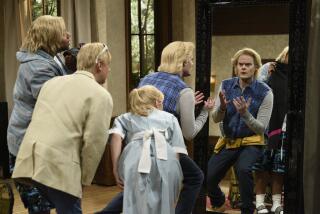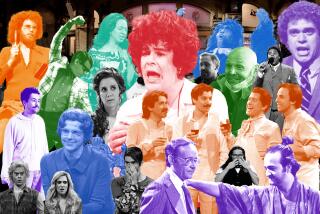Three great sitcom sets for last-minute holiday shoppers
I am going to use the excuse that it’s Christmas next week and you may have some shopping left to do to review three DVD sets I have been meaning to write about for months. (Something came up.) All are comedies. Two are complete sets and one is the first installment in what will eventually be a complete set, if you buy enough of volume one to economically justify a volume two. Artistically, there is no question of justification: All are brilliant and a little strange: Two -- “The Sarah Silverman Program” and Chris Elliott’s “Get a Life” -- play with sitcom conventions; the other is plain unconventional.
That is “I’m Dickens, He’s Fenster,” which ran for a single season in 1962-63 on ABC. The first 16 of its 32 episodes -- they grew their seasons long in those days -- appeared for the first time on DVD this April as “‘I’m Dickens, He’s Fenster’ 50th Anniversary Collectors Edition: Volume 1” (Lightyear Entertainment). It was created by the great Leonard Stern, who had already written for “The Honeymooners” and “Sergeant Bilko” and would produce, write and direct “Get Smart” and create the Richard Benjamin-Paula Prentiss sitcom “He & She,” which I would very much like to see again, and “McMillan & Wife,” which I have been admiring with fresh eyes online. (I will get around to writing about that show soon, Rock Hudson/Susan Saint James/Nancy Walker/John Schuck fans.) He also co-created Mad Libs, the party game.
HERO COMPLEX: Holiday gift guide 2012
Starring sad-eyed John Astin (soon to play Gomez on “The Addams Family”) and raspy-voiced Marty Ingels as carpenters Harry Dickens and Arch Fenster, it is a sort of proto-bromance, with its overriding theme the platonic and almost pathological love between two men -- a love they declare outright, with a sincerity that feels jarring in our supposedly freer but compulsively ironic time.
The arrival of a stray dog or a new neighbor is all it takes to send one or the other into a fit of jealousy; it is the anniversary of their friendship Harry remembers to celebrate, not that of his marriage, to blond-and-brassy-in-a-classy-way Emmaline Henry (later Mrs. Bellows on “I Dream of Jeannie”), who is remarkably patient -- Harry has an unsettling, almost Freudian tendency, to flirty with the glamour girls Arch dates, while Arch climbs in through her bedroom window in order to save them answering the door -- but never a doormat. There are at least two episodes in which Harry and Arch share a bedroom.
It is also a show about the working class, who get little respect on television nowadays. And it’s distinguished from most situation comedies of any era, and certainly of the shot-live, multi-camera sort, by the amount of slapstick it contains -- “I Love Lucy” being the obvious exception. (Astin is particularly adept at pratfalls; he has a real way with walking into a closed door.) And it has a sense of the satire: In one Swiftean episode, disagreement over whether a joke is funny or not escalates into armed warfare.
There is a childlike quality to Arch and Harry that describes as well, to different effects, the heroes of “Get a Life” and “The Sarah Silverman Program.” (“She’s technically an adult,” one character says of Silverman.) Each series is set in a twisted and sometimes supernatural version of the world that old-fashioned sitcoms suggest, features a central character sent to test your patience, and is more than usually Not for Everyone.
The three seasons of “The Sarah Silverman Program,” which ran from 2007 to 2010 on Comedy Central (with a year off in 2009), have been gathered together in a single box by Shout Factory, with some new extra features. They hold up well, across time and repeated viewings. A word like “irreverent” describes the series accurately enough, and yet somehow does not do it justice; and “transgressive” is frankly no fun. Irony is the main weapon in its comic-rhetorical arsenal -- the whole show pulses with a bright storybook whimsicality often at odds with its subject matter, which includes abortion, gender issues, marriage equality, pedophilia, homelessness, AIDS and the Holocaust -- but also farts and feces.
“Sarah Silverman” feels big: Its crowd scenes are well-populated; there are musical numbers, animations, puppets, an action-film parody. The images are fresh and bright, with a small-townish setting and helpful characters out of an elementary-school primer: Sarah’s sister Laura (played by Silverman’s sister Laura, the voice of the receptionist on “Dr. Katz, Professional Therapist”), who pays her rent, is a nurse; Laura’s boyfriend, Jay, Johnston, is a policeman. (His partners were played in turn by the comics Paul F. Tompkins and Tig Notaro).
Best of 2012: Video Games | Art | Theater | Awesome
The Sarah of the series (who is not a comedian, and indeed labors at nothing at all) has no ambition other than to be loved unconditionally by everyone, which she regards as a kind of favor to the universe. She creates drama where there is none -- it only takes losing her keys for Sarah to see herself not only as homeless, but heroically brave -- and when things are set right around her, she takes the wrong lesson from it.
Though Sarah believes herself to be an extremely good person, she is capable of “firing” and replacing her best friends -- she brings in a grief counselor to help them cope -- and is offended when a wheelchair race, which she calls “cheating,” blocks her way to the store where she’s headed to buy batteries so she can change the channel on her television away from a charity appeal on behalf of starving children. She sleeps with God and dumps him when he becomes too needy -- then gets back together with him when she wants a date to show off at her high school reunion.
There is a second, contrasting and, all things considered, kind of sincere strain in the show, however, regarding its couples -- Laura and Jay, and Sarah’s “gigantic, orange and gay” slacker neighbors Brian and Steve (Brian Posehn and Steve Agee) -- and what people do for those they love. Like when Jay starts having “laughmares,” Laura stages a talk-show in their bedroom to give his unconscious hilarity context, or when Steve finally expresses his support of Brian in his campaign to pay back a bird for defecating on his head. Clever readers may imagine the form this revenge takes.
This exchange expresses the show’s method pretty well:
Jay: My partner got suspended because this Hispanic kid pulls a gun on him, Paul opens fire. Turns out it’s a pellet gun. It looked really real, though.
Laura: There should be a law that those things have to come in bright colors.
Sarah: Laura, they’re human beings!
Chris Elliott’s “Get a Life,” which lasted two seasons on Fox, from 1990-92, was also issued whole this year, as “Get a Life: The Complete Series -- Un-special non-anniversary edition” (Shout Factory). There is something particularly unsettling and unlikely about this series, which features Elliott, known from appearances on “Late Night with David Letterman,” as a 30-year-old paperboy, living with his parents, played by Elliott’s own father, the Bob of Bob & Ray, and Elinor Donahue, the elder daughter on “Father Knows Best.” They are usually seen in their bathrobes, in their breakfast nook, and they dote not on their son but his hoped-for absence; his father, especially is not particular as to how. (He does move out in the second season, into the garage of not particularly scrupulous ex-cop Brian Doyle-Murray.)
Best of 2012: Movies | TV | Pop music | Jazz
Like Silverman’s character, Chris’ Chris Peterson is an idiot and an optimist, with great reserves of self-regard, though with some sense of duty to others. And his life is not quite as charmed as Sarah’s; he is often physically attacked in the series, and dies more than once. Perhaps it’s because he is not as pretty as she, although he is willing to believe he is. In the Handsome Boy Modeling School episode, he becomes a male model -- professional name: Sparkles.
All sorts of things happen to Chris: A near-death experience makes him psychic; an Indian curse causes him to switch places with his best friend (Sam Robards) whose wife is his series-long enemy; he goes head to head with a robot paperboy; he becomes a food inspector and is intoxicated by $5 bribes; he becomes an escort; he has his tonsils out. His reactions are usually overwrought, his expressions often florid and creepily formal.
It’s not quite the “cringeworthy” comedy of a Ricky Gervais or a Larry David, but something more akin to the outrageous gestures of an Andy Kaufman. (It’s not surprising to learn that Charlie Kaufman, who wrote “Being John Malkovich” and “Eternal Sunshine of a Spotless Mind,” wrote for the series, as did Bob Odenkirk.) There is something not quite formed about Elliott himself, who is big and soft-edged, in an almost larval way. His character here reminds me at times of one of those Charles Ray sculptures where naked children and adults are all the same size. One feature of the DVD set is that you can play certain episodes without a laugh track: With the track in, “Get a Life” plays more like a parody of situation comedy; with the track out, its oddness floats like cream to the surface, and you see it for the singular thing it is.
PHOTOS AND MORE
VIDEO: The making of ‘Argo,’ ‘Les Miz’ and more
VIDEO: Holiday movies - A video guide
PHOTOS: NC-17 movies: Ratings explained
More to Read
The complete guide to home viewing
Get Screen Gab for everything about the TV shows and streaming movies everyone’s talking about.
You may occasionally receive promotional content from the Los Angeles Times.







